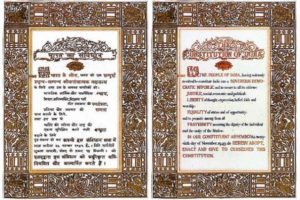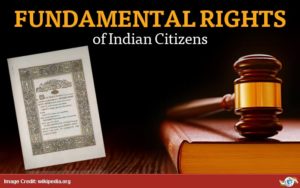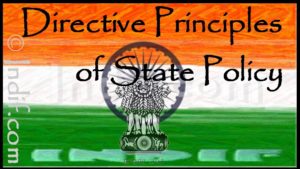What is a Constitution?
It’s a law determining the fundamental political principles of a government, in other words, it’s that fundamental law which binds every other law, which guarantees it’s citizens their rights and stipulates their duties, which governs the conduct of government. Creating a law/constitution is not just an imaginative creation of a book to regulate, it’s a creative visualization of such civilization which frees itself from the age-old ancient believes and strives for a dreamland which our mother Earth always dreams of.A constitution to a nation is an identity of its nation, which is not just a reflection of their ideas but also a place where they evaluate, analyze and improve themselves. Here is All you need to know about Indian Constitution and its parts.
What does Indian Constitution say about us? What are its constituents?
Our constitution-the lengthiest written constitution, a blend of rigid and flexible features comprised of a preamble, 395 articled and 8 schedules, made up of approximately 145,000 words making it a second largest active constitution in the world when it was first adopted on November 26, 1949, with 298 signatories. Now it has a preamble, 25 parts with 448 articles, 12 schedules and, 5 appendices and 101 amendments.
Preamble of Indian Constitution:-
A preamble to a constitution is an outline or gist of what actually constitution says about its nation. It was referred to as an “identity card of constitution” by N.A.Palkhivala, an eminent jurist, and a constitutional expert. The preamble of our constitution is more or less similar to the objectives resolution, drafted and moves by our Chacha Pandit Nehru and passed unanimously by the constituent assembly on 22nd January 1947. This is the preamble to our Constitution which :

– states that constitution derives its authorities from the people of India.
– declares, India to be a sovereign socialist secular democratic republic.
– specifies, Justice, Liberty, Equality, and Fraternity as its objectives
– stipulates 26th November 1949 as the day of adoption if constitution.
Read More: How Indian Parliament Has Declined Over The Years?
However, two things are to be noted in this regard :
1. The preamble is neither a source of power to legislature nor a prohibition upon the powers of the legislature.
2. It is non-justiciable, that is, its provisions are not enforceable in the courts of law.
There was a controversy regarding the preamble ad to whether it is a part of Indian constitution or not?
The judicial courts in the famous Berubari union case In 1960 held that preamble is not a part of the constitution despite recognizing its significance as to in case any terms in the constitution are found ambiguous or capable of interpreting more than one meaning, then reference can be drawn to the preamble, if applicable.
However, again in Keshavananda Bharati case in 1971, the supreme court in light of facts of the case and with the interpretations of noble vision of our forefathers’ held that preamble is a part of our constitution and the decision held in the previous case was regarded wrong. It was also held that preamble, as a part if constitution can be amendable by parliament subject to the condition that no amendment can be done the parliament destroying or emasculating the Basic structure or basic elements or fundamental features of the constitution.
Since then, supreme court adopted basic structure doctrine in all the respective subsequent cases which made this case as a case which redefined the democracy of India protecting the totalitarian encroachment of constitution by parliament. This with this, 42nd amendment including the words social, secular and integrity became valid.
Parts of Indian Constitution:-
The 25 parts of Indian constitution comprising of 448 articles addresses and constitute the fundamental basis for every law in our country.
Part 1: Union and its territories. It defines the territory
Part 2: Citizenship
Part 3: Fundamental rights.
Part 4: directive principles of state policy
Part 4A: fundamental duties
Part 5: the union
Part 6: the states.
Part 7: states in B part of the first schedule (repealed)
Part 8: union territories
Part 9: the municipalities
Part 9B: The cooperative societies.
Part 10: Scheduled and tribal areas.
Part 11: relation between union and states
Part 12: finance, property, contracts, and suits
Part 13: trade and commerce within Indian territory
Part 14: e-services under the union, the states
Part 14A: the tribunals
Part 15: Elections
Part 16: Special provisions relating to certain clauses
Part 17: Languages
Part 18: Emergency provisions
Part 19: Miscellaneous
Part 20: Amendment to the constitution
Part 21: Temporary, transitional and special provisions.
Part 22: Short title, date of commencement, authoritative text in Hindi and repeals.
These 25 parts are the essence and substance of Indian constitution, just going through a glimpse of it, one can understand the constituents of Indian constitution.
Read more: Does India Need A Presidential Form Of Government?
Schedules of Indian Constitution:-
Schedules tabulate and elaborate the bureaucracy and policies of the government.
Schedule 1: Lists of states and union territories and laws made to amend.
Schedule 2: This lists the salaries of officials holding public offices, judges and CAG.
Schedule 3: This lists the forms of oaths of elected officials and judges
Schedule 4: Allocation of Rajya Sabha seats per state or UT.
Schedule 5: administration of scheduled and scheduled tribal areas.
Schedule 6: administration of tribal areas in Mizoram, Assam, Meghalaya, and Tripura.
Schedule 7: The union, state and concurrent lists of responsibilities.
Schedule 8: Official languages
Schedule 9: Validation of certain acts and regulations
Schedule 10: Anti-defecation provisions for MP’s and MLA’s
Schedule 11: Panchayat raj
Schedule 12: Municipalities
Appendices of Indian Constitution:-
1. The constitution order, 1954
2. Applicabilities to J&K
3. Extract from constitution amendment act,1978
4. Constitution(86th) amendment act, 2002
5. Constitution (88th) amendment act, 2003
What are the salient features of Indian constitution?
Indian constitution despite being the lengthiest written, second largest constitution and being called a compiler of various constitutions, it stands separate and has some outstanding features
· Universal Adult franchise :
The bold move was taken by Constituent assembly which strengthened the democracy of our country by giving every individual who attained the age of 18, a right to vote.Right to vote is granted to every individual irrespective of any discrimination in any form.
· Three tier government:
Our constitution is a federal constitution has a dual polity system of governance. Later with the introduction of 73rd and 74th constitutional amendment acts, a third tier government at the local level has been introduced which was the first in the world.

· Fundamental rights of Indian Constitution:-
The Constituent Assembly has actually proposed seven fundamental rights for citizens of India viz,
1. Right to equality (articles 14-18)
(a) Equality before the law and equal protection of laws (Article 14).
(b) Prohibition of discrimination on grounds of religion, race, caste, sex or place of birth (Article 15).
(c) Equality of opportunity in matters of public employment (Article 16).
(d) Abolition of untouchability and prohibition of its practice (Article 17).
(e) Abolition of titles except military and academic (Article 18).
2.Right to freedom(Articles 19–22)
(a) Protection of six rights regarding freedom of (i) speech and expression, (ii) assembly, (iii) association
(iv) movement, (v) residence, and (vi) profession (Article 19).
(b) Protection in respect of conviction for offenses (Article 20).
(c) Protection of life and personal liberty (Article 21).
(d) Right to elementary education (Article 21A).
(e) Protection against arrest and detention in certain cases (Article 22).
3.Right against exploitation (Articles 23–24)
(a) Prohibition of traffic in human beings and forced labor (Article 23).
(b) Prohibition of employment of children in factories, etc. (Article 24).
4.Right to freedom of religion (Article 25–28)
(a) Freedom of conscience and free profession, practice and propagation of religion (Article 25).
(b) Freedom to manage religious affairs (Article 26).
(c) Freedom from payment of taxes for promotion of any religion (Article 27).
(d) Freedom from attending religious instruction or worship in certain educational institutions (Article 28).
5.Cultural and educational rights (Articles 29–30)
(a) Protection of language, script, and culture of minorities (Article 29).
(b) Right of minorities to establish and administer educational institutions (Article 30).
6.Right to constitutional remedies (Article 32)
Right to move the Supreme Court for the enforcement of fundamental rights including the writs of
(i) habeas corpus, (ii) mandamus, (iii) prohibition, (iv) certiorari, and (v) quo warranto (Article 32).
Fundamental rights have some special features which say that any law which ultra vires the fundamental rights are null and void.They are justiciable too, that is, they are enforceable in the court of law.Any person who was deprived of any of the fundamental rights can sue for it and remedies such as habeas corpus, mandamus, certiorari, quo-warranto, prohibition are available.
Read More: Independence Day Special – Part 1 : The Independence Of India And The Integration Of Princely States
There was also famous Maneka Gandhi case regarding the right to freedom wherein, she claimed for her dignity. Supreme court held that right of freedom includes all types freedom to live a life with dignity and honor. So with this opinion, the purview of right to freedom has been enhanced and included 22 rights in its scope.

· Directive principles of state policy :
These principles are those which are not justiciable in nature, I.e. they cannot be enforced in the court of law. BUT they are considered to be goals which we should attain in other words they lay moral obligation on people.
Classification of the Directive Principles
The Constitution does not contain any classification of Directive Principles. However, on the basis of
their content and direction, they can be classified into three broad categories, viz, socialistic,
Gandhian and liberal–intellectual.
Socialistic Principles
These principles reflect the ideology of socialism. They lay down the framework of a democratic socialist state, aim at providing social and economic justice, and set the path towards a welfare state.
They direct the state:
1.To promote the welfare of the people by securing a social order permeated by justice—social, economic and political—and to minimise inequalities in income, status, facilities, and opportunities. (Article 38).
2.To secure (a) the right to adequate means of livelihood for all citizens; (b) the equitable distribution of material resources of the community for the common good; (c) prevention of concentration of wealth and means of production; (d) equal pay for equal work for men and women; (e) preservation of the health and strength of workers and children against forcible abuse; and (f) opportunities for healthy development of children5 (Article 39).
3.To promote equal justice and to provide free legal aid to the poor. (Article 39 A).
4.To secure the right to work, to education and to public assistance in cases of unemployment, old age, sickness and disablement (Article 41).
5.To make provision for just and humane conditions for work and maternity relief (Article 42).
6.To secure a living wage7, a decent standard of living and social and cultural opportunities for all workers (Article 43).
7.To take steps to secure the participation of workers in the management of industries. (Article 43 A).
8.To raise the level of nutrition and the standard of living of people and to improve public health.
Gandhian Principles:-
These principles are based on Gandhian ideology. They represent the programme of reconstruction enunciated by Gandhi during the national movement. In order to fulfill the dreams of Gandhi, some of his ideas were included as Directive Principles. They require the State:
1.To organize village panchayats and endow them with necessary powers and authority to enable them to function as units of self-government (Article 40).
2.To promote cottage industries on an individual or co-operation basis in rural areas (Article 43).
3.To promote voluntary formation, autonomous functioning, democratic control and professional management of co-operative societies. (Article 43B).
4.To promote the educational and economic interests of SCs, STs, and other weaker sections of the society and to protect them from social injustice and exploitation (Article 46).
5.To prohibit the consumption of intoxicating drinks and drugs which are injurious to health (Article 47).
6.To prohibit the slaughter of cows, calves and other milch and draught cattle and to improve their breeds (Article 48).
Liberal–Intellectual Principles:-
The principles included in this category represents the ideology of liberalism. They direct the state:
1.To secure for all citizens a uniform civil code throughout the country (Article 44).
2.To provide early childhood care and education for all children until they complete the age of
six years (Article 45).
3.To organize agriculture and animal husbandry on modern and scientific lines (Article 48).
4.To protect and improve the environment and to safeguard forests and wild life10 (Article 48A).
5.To protect monuments, places, and objects of artistic or historic interest which are declared to be of national importance (Article 49).
6.To separate the judiciary from the executive in the public services of the State (Article 50).
7.To promote international peace and security and maintain just and honorable relations between nations; to foster respect for international law and treaty obligations, and to encourage settlement of international disputes by arbitration (Article 51).
New Directive Principles
The 42nd Amendment Act of 1976 added four new Directive Principles to the original list. They require the State:
1.To secure opportunities for healthy development of children (Article 39).
2.To promote equal justice and to provide free legal aid to the poor (Article 39 A).
3.To take steps to secure the participation of workers in the management of industries (Article 43 A).
4.To protect and improve the environment and to safeguard forests and wildlife (Article 48 A).
The 44th Amendment Act of 1978 added one more Directive Principle, which requires the State to minimise inequalities in income, status, facilities, and opportunities (Article 38).
Again, the 86th Amendment Act of 2002 changed the subject-matter of Article 45 and made elementary education a fundamental right under Article 21 A. The amended directive requires the State to provide early childhood care and education for all children until they complete the age of six years.
The 97th Amendment Act of 2011 added a new Directive Principle relating to co-operative societies. It requires the state to promote voluntary formation, autonomous functioning, democratic control and professional management of co-operative societies (Article 43B).
Fundamental duties of Indian Constitution:-
Duties of a citizen are not mentioned during formation of the constitution but were added through amendment act subsequently.
According to Article 51 A, it shall be the duty of every citizen of India:
(a)to abide by the Constitution and respect its ideals and institutions, the National Flag and the National Anthem;
(b)to cherish and follow the noble ideals that inspired the national struggle for freedom;
(c)to uphold and protect the sovereignty, unity, and integrity of India;
(d)to defend the country and render national service when called upon to do so;
(e)to promote harmony and the spirit of common brotherhood amongst all the people of India transcending religious, linguistic and regional or sectional diversities and to renounce practices derogatory to the dignity of women;
(f)to value and preserve the rich heritage of the country’s composite culture;
(g)to protect and improve the natural environment including forests, lakes, rivers, and wildlife and to have compassion for living creatures;
(h)to develop scientific temper, humanism and the spirit of inquiry and reform;
(i)to safeguard public property and to abjure violence;
(j)to strive towards excellence in all spheres of individual and collective activity so that the nation constantly rises to higher levels of endeavor and achievement; and
(k)to provide opportunities for education to his child or ward between the age of six and fourteen years. This duty was added by the 86th Constitutional Amendment Act, 2002.
